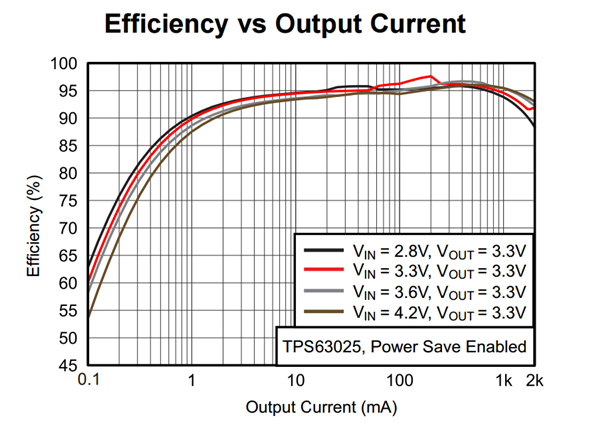Small, Efficient Buck-boost for Portable Industrial Equipment
Chris Glaser

Almost every portable system needs a 3.3V rail. And for those systems powered by single-cell lithium batteries, there is always a question of how to make this rail. Stepping up the battery voltage (which typically varies from 3V to 4.2V) to 5V and then stepping the 5V down to 3.3V causes the power to go through double conversion. The efficiency of two power-conversion steps is the product of the efficiency of each of those steps, so the overall efficiency for the scenario I’ve described is low. For example, if the step-up converter is 90% efficient and the step-down converter is 95% efficient, the overall efficiency is just 85.5%. There must be a better way to generate the 3.3V that wastes less power.
Using the TPS63025 buck-boost converter family provides higher efficiencies in these types of situations. By combining a >95% efficiency step-down converter and a >90% efficient step-up converter, the conversion efficiency is either >95% or >90% based on the battery voltage (see Figure 1). A buck-boost converter does not double-convert the power, but rather operates as a step-down or step-up converter as needed. Efficiency increases, which reduces temperature rise and increases the run time of the battery.
 Figure 1 TPS63025 Efficiency vs. Output
Current
Figure 1 TPS63025 Efficiency vs. Output
CurrentYou can design such a buck-boost converter into almost any portable system. If you are designing a smartphone, a wafer chip-scale (WCSP) package provides the smallest solution size and is easily manufactured in high-density systems. But for industrial equipment such as barcode scanners, you’re not fighting for every square millimeter of printed circuit board (PCB). These types of applications can use a standard quad flat no-lead (QFN)-type package, which has solder fillets and can be visually inspected during manufacturing.
With the new buck-boost converters, the TPS630250 and the TPS63050 family of devices, engineers now have their choice of packages. For the absolute smallest size, the YFF package (WCSP) is preferable, while for less demanding manufacturing requirements, the RNC package (QFN) is available. Either way, these devices provide a 3.3V rail from a single-cell lithium battery with over 90% efficiency – giving engineers more choices and more applications.
What Applications Do You Have Which Should You Not Use a WCSP Package?
IMPORTANT NOTICE AND DISCLAIMER
TI PROVIDES TECHNICAL AND RELIABILITY DATA (INCLUDING DATASHEETS), DESIGN RESOURCES (INCLUDING REFERENCE DESIGNS), APPLICATION OR OTHER DESIGN ADVICE, WEB TOOLS, SAFETY INFORMATION, AND OTHER RESOURCES “AS IS” AND WITH ALL FAULTS, AND DISCLAIMS ALL WARRANTIES, EXPRESS AND IMPLIED, INCLUDING WITHOUT LIMITATION ANY IMPLIED WARRANTIES OF MERCHANTABILITY, FITNESS FOR A PARTICULAR PURPOSE OR NON-INFRINGEMENT OF THIRD PARTY INTELLECTUAL PROPERTY RIGHTS.
These resources are intended for skilled developers designing with TI products. You are solely responsible for (1) selecting the appropriate TI products for your application, (2) designing, validating and testing your application, and (3) ensuring your application meets applicable standards, and any other safety, security, or other requirements. These resources are subject to change without notice. TI grants you permission to use these resources only for development of an application that uses the TI products described in the resource. Other reproduction and display of these resources is prohibited. No license is granted to any other TI intellectual property right or to any third party intellectual property right. TI disclaims responsibility for, and you will fully indemnify TI and its representatives against, any claims, damages, costs, losses, and liabilities arising out of your use of these resources.
TI’s products are provided subject to TI’s Terms of Sale (www.ti.com/legal/termsofsale.html) or other applicable terms available either on ti.com or provided in conjunction with such TI products. TI’s provision of these resources does not expand or otherwise alter TI’s applicable warranties or warranty disclaimers for TI products.
Mailing Address: Texas Instruments, Post Office Box 655303, Dallas, Texas 75265
Copyright © 2023, Texas Instruments Incorporated